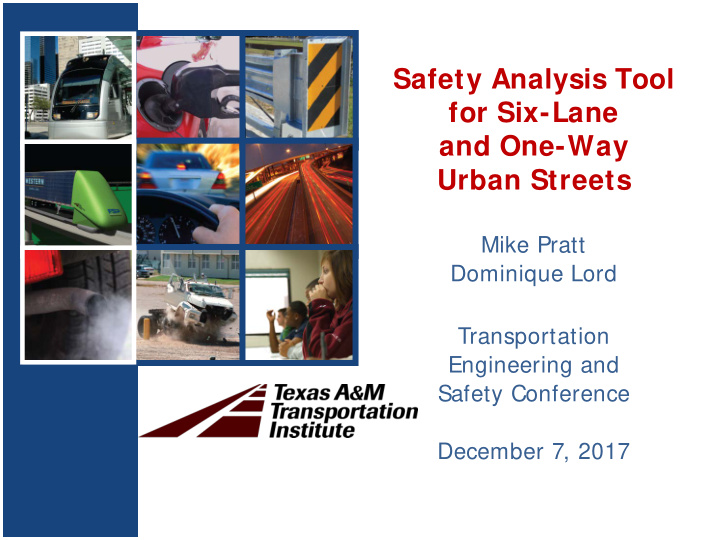



Safety Analysis Tool for Six-Lane and One-Way Urban Streets Mike Pratt Dominique Lord Transportation Engineering and Safety Conference December 7, 2017
Background NCHRP Project 17-58 • “Safety Prediction Models for Six-Lane and One-Way Urban and Suburban Arterials” • PI: Dominique Lord • Co-PI: Kay Fitzpatrick • Key products • Predictive methods to be added to HSM Chapter 12 • Software implementation of methods
Database Assembly
Roadway Predictive Methods Two-Way Arterials – 6-lane undivided (6U) • Multiple-Vehicle • Single-Vehicle – 6-lane divided (6D) • Vehicle-Pedestrian – 6-lane + TWLTL (7T) • Vehicle-Bike – 8-lane divided (8D)
Crash Modification Factors for Two-Way Segments CMFs Produced: Lane Width Outside Shoulder Width Median Width Median Barrier – MV crashes & SV crashes Major Commercial Driveways Major Industrial Driveways Minor Driveways Roadside Fixed Objects
Roadway Predictive Methods One-Way Arterials • Multiple-Vehicle – 2-lane (2O) • Single-Vehicle • Vehicle-Pedestrian – 3-lane (3O) • Vehicle-Bike – 4-lane (4O)
Crash Modification Factors for One-Way Segments CMFs Produced: Right Shoulder Width On-street Parking - Parallel and Angle Major Commercial Driveway Minor Driveway Roadside Fixed Objects
I ntersection Predictive Methods • Two-Way Streets (2x2) • MV + SV – Three-Leg Signalized (3SG) – Three-Leg Unsignalized (3ST) • Vehicle-Pedestrian – Four-Leg Signalized (4SG) • Vehicle-Bike – Four-Leg Unsignalized (4ST)
I ntersection Predictive Methods • One-Way Streets Signalized Intersections (3SG & 4SG) One-way/Two-Way (1x2) • MV + SV One-Way/One-Way (1x1) • Vehicle-Pedestrian Unsignalized Intersections (3ST & 4ST) • Vehicle-Bike One-way/Two-Way (1x2) One-Way/One-Way (1x1)
Crash Modification Factors for I ntersections 2x2 Intersections 1x2/1x1 Intersections CMFs Produced: CMFs Produced: Left-turn signal phasing Number of lanes U-turn prohibition CMFs Validated: Right-turn channelization Lighting Number of lanes Note: CMFs Validated: 2x2 or 1x1 intersections: Lighting Major AADT > Minor AADT RTOR prohibition 1x2 intersections: Major street = One-way
Segmentation Process • Overview – Divide continuous roadway section into sites • Homogenous segments (same basic character for entire length) • Intersections 2 1 3
Segmentation Process • Procedure – Describe each site • Geometry • Traffic control • Traffic volumes • Enter into Segments and Intersections worksheets – Tabulate • Use Totals worksheet • Compute predicted crash frequency
Software Tool Individual Adjacent roadway Individual 6U, 6D, 7T, and • 2 × 2 intersections with 6+ lanes segments and intersections Individual 2O, 3O, and 4O 8D roadway segments • 1 × 2 or 1 × 1 intersections forming an arterial facility roadway segments
Enter Data Purple cells: results Blue cells: input data Red text: notes Yellow cells: calibration factors
Example Problem • Given – Six-lane divided arterial section • Study period: 2016 • Highway-rail grade crossings: 1 • Area type: Urban • Roadside fixed object offset: 10 ft • No crash data available • Roadside fixed object density: 50/mi • Segment length: 0.30 mi • Major commercial driveways: 1 • Posted speed limit: 45 mph • Major industrial driveways: 1 • Lane width: 12 ft • Minor driveways: 5 • Outside shoulder width: 4 ft • AADT (year 2016): 56,000 veh/day • Median width: 10 ft • Median type: curb • Automated speed enforcement: No
Example Problem • Question – What is the predicted crash frequency? • Answer – 7.5 crashes / yr • Follow-up question – What is the predicted crash frequency if the two major driveways are removed? • Answer – 6.5 crashes / yr
Questions – Comments?
Thank You! • Mike Pratt: m-pratt@tamu.edu • Dominique Lord: d-lord@tamu.edu
Recommend
More recommend